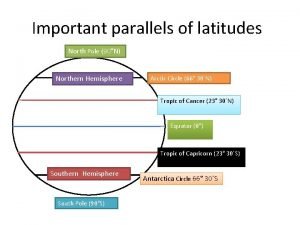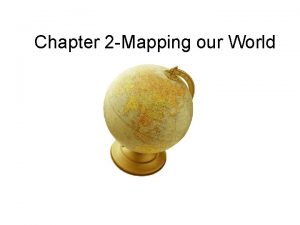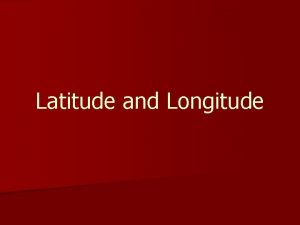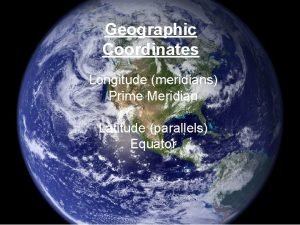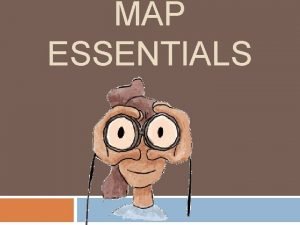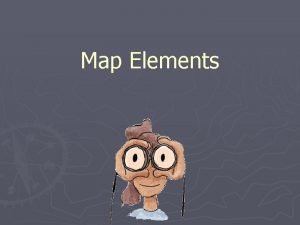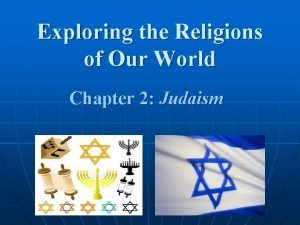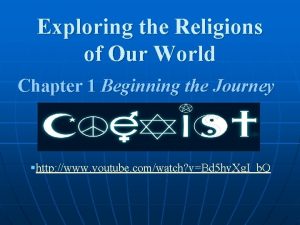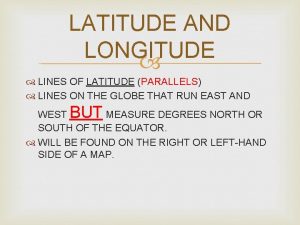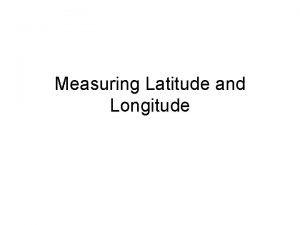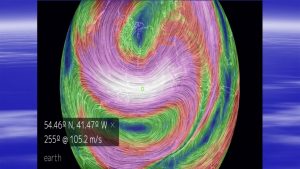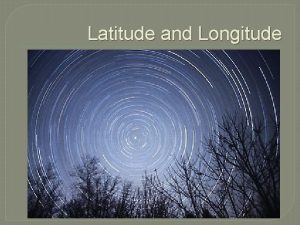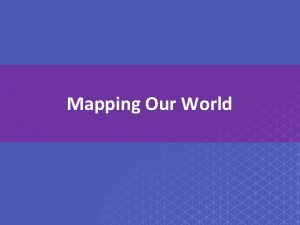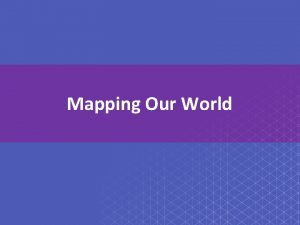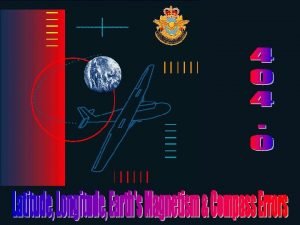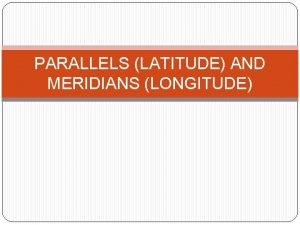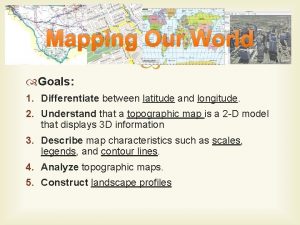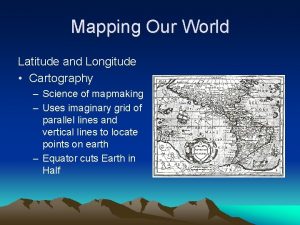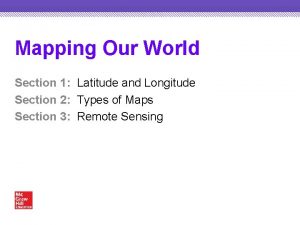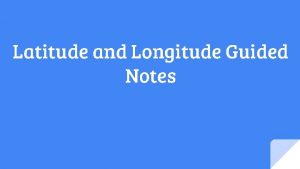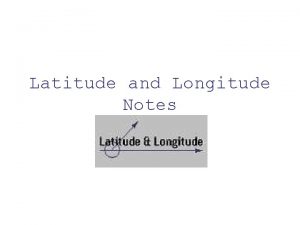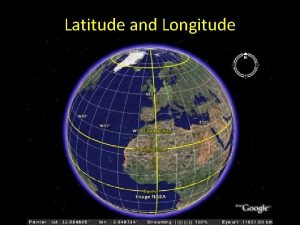Chapter 2 Mapping Our World Latitude parallels The




















- Slides: 20

Chapter 2: Mapping Our World!

Latitude (parallels) • The science of mapmaking: Cartography! • The equator circles halfway between the North and South poles. This separates the world into two equal halves: northern and southern hemisphere. • The poles are located at 90 latitude. • Latitude is the distance in degrees north or south of the equator. • Each degree of latitude is about 111 km on Earth’s surface. • Run parallel to the equator (reference point)

Where did 111 km come from? • Earth is a sphere and can be divided into 360 degrees. The circumference of Earth is about 40, 000 km. • For the distance of each degree of latitude, divide 40, 000 km by 360, which equals 111 km. • To locate positions on earth more precisely, we break down degrees of latitude into 60 smaller units, called minutes. The symbol for a minute is ‘. • The actual distance on Earth’s surface of each minute of latitude is 1. 85 km. (111 km divided by 60 minutes) • You can also divide it into seconds. The symbol for seconds is: “

Longitude (meridians) • Longitude: the distance in degrees east or west of the prime meridian, which is the reference point for longitude (0˚ longitude) • Lines of longitude are not parallel. They are large semi-circles that extend vertically from pole to pole. • The international date line is located at 180˚ meridian. This line is on the opposite side of the earth as the prime meridian.

Latitude AND Longitude • Both latitude and longitude are necessary to precisely locate positions on Earth. Latitude ALWAYS comes first when writing coordinates. • Degrees of latitude cover relatively consistent distances, meaning they are relatively equal. • However, degrees of longitude are not parallel, they form semicircles, so their distances will vary.

Time Zones • Earth is separated into 24 time zones. This represents the 24 hours in one day. Every hour, the Earth spins approximately 15˚. Therefore, each time zone is about 15˚ wide.

2. 2: TYPES OF MAPS

Mercator Projections • A map that has parallel lines of latitude and longitude. On this map, the shapes of the landmasses are correct, but their areas are distorted. • Greenland appears much larger than Australia. In reality, AU is MUCH larger. • This type of projection is used in navigation of planes and ships. This Photo by Unknown Author is licensed under CC BY-SA

Conic Projections • A conic projection is made by projecting points and lines from a globe onto a paper cone. • The cone touches the globe at a particular line of latitude, where some distortion of land masses will occur. Distortion will also occur near the top and bottom of the projection. • Excellent for mapping small areas, so these maps are used in road maps and weather maps.

Gnomonic Projections • Made by projecting points and lines from a globe onto a piece of paper that touches the globe at a single point. • At the single point, there is no distortion, but outside of that point distortion is heavy. • While there is distortion, it still shows the quickest travel routes for navigation. A straight line on a gnomonic projection is the straightest path from A to B.

Topographic Maps • Show changes in elevation on Earth’s surface. They also show rivers, mountains, forests, bridges, etc. • Use lines, symbols, and colors to represent changes in elevation. • Elevation on a topographic map is represented by a contour lines.

Contour Lines and Contour Intervals • Contour lines connect points of equal elevation. These never cross. If they did, the point at which they cross would mean that point has 2 different elevations, which is impossible. • Contour interval: the difference in elevation between two side-by-side contour lines on a topographic map. • The closer an interval, the steeper it is. • Depression Contour Lines are used to represent land lower than the surrounding landscape. They look like regular contour lines, but contain short lines at right angles, known as hachures. The short lines point to the lower elevation.

This Photo by Unknown Author is licensed under CC BY

Geologic Map • Geologic map is used to show distribution, arrangement, and type of rocks located below the soil. • Refer to your book, pg. 39 for a table of the map types and the projections.

Map Legends and Map Scales • Map Legend: key that explains what the symbols on a map represent. • Map scale: ratio between the distances shown on a map and the actual distances on Earth’s surface.

2. 3: Remote Sensing

Landsat Satellite • Remote Sensing: Process of gathering data about Earth from instruments far above the planets surface. • Landsat satellites: records reflected wavelengths of energy from Earth’s surface. These include wavelengths of visible light and infrared radiation.

OSTM/Jason-2 Satellite • Uses radar to measure and map sea surface height. • OSTM: Ocean Surface Topography Mission. • Using OSTM/Jason-2 data, scientists are able to estimate global sea levels within a few millimeters. • The distance to the water’s surface is calculated using the known speed of light and the time it takes to reflect the light. • Used forecasting El Nino events.

Sea. Beam • Sea. Beam is located on a ship, instead of a satellite and maps the ocean flood rather than the surface. • Uses sonar- the use of sound waves to detect and measure objects underwater. • A sound wave is sent from the ship toward the ocean floor, a receiving device picks up the returning echo when it bounces off the seafloor. • Computers on the ship calculate the distance using the speed of sound in water and the time it took for the sound to be reflected. • Used by fishing fleets and scientists.

GPS & GIS • Global Positioning System: Satellite-based navigation system that permits a user to pinpoint his or her exact location on Earth. • GPS receiver required. Multiple satellites are required to accurately pinpoint location. • Geographic Information System: mapping system that uses worldwide databases from remote sensing to create layers of information that can be superimposed upon each other to form a comprehensive map.
 Important parallels of latitude
Important parallels of latitude Chapter 2 mapping our world
Chapter 2 mapping our world Chapter 2 study guide mapping our world
Chapter 2 study guide mapping our world Mapping lines of latitude and longitude
Mapping lines of latitude and longitude One eyed assef
One eyed assef The equator divides the earth into
The equator divides the earth into Memory parameters
Memory parameters Forward mapping vs backward mapping
Forward mapping vs backward mapping Prinsip analisis dan desain
Prinsip analisis dan desain Map of latitude lines
Map of latitude lines Http //go.hrw.com/atlas/norm htm/world.htm
Http //go.hrw.com/atlas/norm htm/world.htm Judaismn
Judaismn Exploring the religions of our world chapter 1 pdf
Exploring the religions of our world chapter 1 pdf Thinking affects our language, which then affects our:
Thinking affects our language, which then affects our: Our census our future
Our census our future Christ be our light shine in our hearts
Christ be our light shine in our hearts Marcus aurelius our life is what our thoughts make it
Marcus aurelius our life is what our thoughts make it We bow our hearts we bend our knees
We bow our hearts we bend our knees Our census our future
Our census our future Our life is what our thoughts make it
Our life is what our thoughts make it Money madness poem by dh lawrence
Money madness poem by dh lawrence
